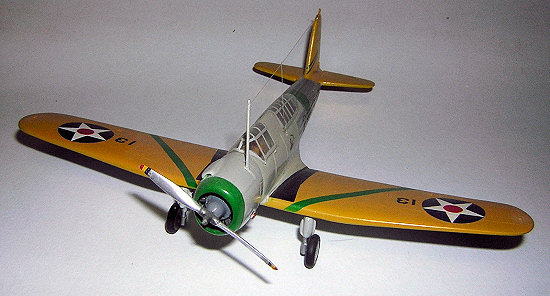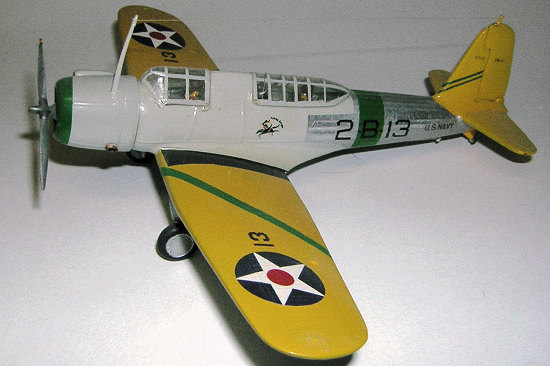
| KIT #: | ? |
| PRICE: | $ Looooong out of production (thankfully) |
| DECALS: | One option |
| REVIEWER: | Joel Hamm |
| NOTES: | About as short run as you can get and not be a VeeDay kit (old timers will know what I mean. Ed) |

| HISTORY |
It is understandable that in the years just before WWII, the Navies of the world that had carrier aircraft would tend to be a bit more conservative than their Army compatriots. The design of Naval aircraft have to take into consideration factors that just are not required for land-based aircraft. Navy planes have to have a slow landing speed in order to alight on a ship. They also need stronger than normal landing gear to handle the pounding. Finally, having folding wings is needed in many cases to allow for more aircraft to be carried onboard the ships.
When it came to bombers, Naval bombers were generally
biplanes; as much for slow landing speed as anything else. Naval bombing
basically meant dive bombing. It is by far the best way of attacking a moving
target such as a ship as it offers much
 greater precision. This
precision is obtained by having the plane get quite close to the enemy ship
before releasing its bomb. Stresses of pullout are high, again, requiring a
sturdy aircraft.
greater precision. This
precision is obtained by having the plane get quite close to the enemy ship
before releasing its bomb. Stresses of pullout are high, again, requiring a
sturdy aircraft.
In mid 1934, Vought offered the US Navy a design for a monoplane bomber. This was the XSB2U, an aircraft that could carry a 1,000 lb bomb and had folding wings for carrier stowage. In addition to being Vought's first monoplane, it was the first USN carrier-borne plane to have retractable landing gear.
Vought had an excellent relationship with the Navy and an order for 54 SB2U-1 aircraft was placed in 1936. This was followed by similar-sized orders for the SB2U-2 and SB2U-3. Each following aircraft improved on the previous one in terms of armor plating, armament and engine power. All of the SB2U-1/2 versions were delivered to the Navy and served on the various carriers as the standard bomber until replaced by the SBD Dauntless.
Those Vindicators that saw action during the opening days of the Pacific war were SB2U-3 versions, the entire lot of which were ordered for the Marines. These planes quickly showed that, through crew inexperience as much as anything, they were not able to withstand modern warfare and were decimated by the defending Japanese. The SB2Us were quickly withdrawn from front line service and sent to training commands where they provided yeoman service until withdrawn in 1943. Ed
The Vindicator is a strange kit subject. For most of the history of plastic modeling it went unknown. Even the vacu-formers passed it by. Then one day it got discovered. Everyone and his Aunt Matilda began kitting it in every scale, variant, and livery. After-marketers started pumping resin into rubber molds and dunking brass into etching baths. Decal makers pumped out so many markings that their Alps printers were left panting and smoking. There are so many reviews on this and related sites that repeating the A/C’s history would be redundant (but your editor included one anyway).
| THE KIT |
All this recognition was started by one of the earliest pioneers in “off the wall” model subjects and back yard injection molding – the British Merlin Company. That name doesn’t exactly strike fear into the hearts of modelers; but it does draw semi-disgusted smirks of “Oh, one of THOSE…” Yes, one of THOSE was never a simple Sunday afternoon stick-it-together session; but with a touch of skill, an excess of patience, a large tube of putty, and a heaping pile of spare parts, a Merlin kit could be turned into an acceptable replica of a plane other modelers never expected to exist, in miniature or real life. {Above applies equally to Meikraft}
| CONSTRUCTION |
 Plastic was thick and waxy. Sprue gates had to be severed with a chainsaw.
Despite these endearments the SB2U was one of Merlin’s (or Meikraft’s) better
kits, owing to keeping things simple. Wings were cast solid, forming a
reasonable airfoil, rather than the impossible-to-remedy blown-up-balloon camber
that resulted anytime someone tried to mold them in halves. As a side effect,
all flying surfaces were thick and slab-like, which, in the absence of
alternates, had to be accepted, as the low tech styrene never took kindly to
files and sandpaper.
Plastic was thick and waxy. Sprue gates had to be severed with a chainsaw.
Despite these endearments the SB2U was one of Merlin’s (or Meikraft’s) better
kits, owing to keeping things simple. Wings were cast solid, forming a
reasonable airfoil, rather than the impossible-to-remedy blown-up-balloon camber
that resulted anytime someone tried to mold them in halves. As a side effect,
all flying surfaces were thick and slab-like, which, in the absence of
alternates, had to be accepted, as the low tech styrene never took kindly to
files and sandpaper.
The injected transparencies were scratchy, but too thin to risk polishing (Definitely Merlin as Meicraft canopies were about 3 scale feet thick. Ed). Their fit, at least, was commendable. No doubt because low pressure injection couldn’t produce petite parts, landing gear, props, and similar small pieces were made of white metal, apparently the precursor of resin (another clue that this is a Merlin kit as no Meicraft kit I ever saw had metal parts. Ed). Evidently I replaced them with spares or scratch-builts. Ditto the engine, which required that the cowl be carved more open.
| COLORS & MARKINGS |
I seem to have ended up with 2 shades of fuselage gray, one leaning toward chartreuse. That may have been the fault of the overcoat. At the time I was using Testors Glosscoat, which had a propensity to turn boo-boo brown. Early short run kits didn’t always include decals, at least not acceptable ones. This scheme is a mix of paint and spare transfers.
| CONCLUSIONS |
The stash contains 1/72 Vindicator kits from Pegasus, MPM, Azure, and Lord Knows whom else. Suggestions are welcome on which is the most promising. Or perhaps I’ll concatenate the best parts of each.
| POSTSCRIPT |
 Your editor has had, at
one time, all of these kits mentioned. Both the Merlin and Meicraft kits had the
benefit of being the first ones on the market that were not vacuform kits.
Frankly, the Rareplane vac kit was miles ahead of either of these two just
mentioned and still makes into a very nice model for the 1/72 fan.
Your editor has had, at
one time, all of these kits mentioned. Both the Merlin and Meicraft kits had the
benefit of being the first ones on the market that were not vacuform kits.
Frankly, the Rareplane vac kit was miles ahead of either of these two just
mentioned and still makes into a very nice model for the 1/72 fan.
Nowadays, the kit to have is the
Azur or
MPM or
Special Hobby kit (same
basic mold). Click on the hyperlink to see a review of one to get an idea of
what's up with those. Same with the
Pegasus kit, which came
out several years before the MPM version. While low pressure molding, and all
that that implies, it still makes up into a very nice model if you have one in
your stash.
December 2006 Copyright ModelingMadness.com. All rights reserved. No reproduction in any form without express permission from the editor. If you would like your product reviewed fairly and quickly, please
contact
the editor or see other details in the
Note to
Contributors.